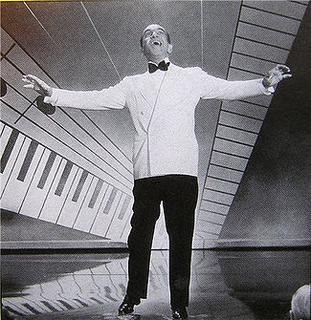Top Qs
Timeline
Chat
Perspective
Wonder Bar
1934 film by Busby Berkeley, Lloyd Bacon From Wikipedia, the free encyclopedia
Remove ads
Wonder Bar is a 1934 American film adaptation of a Broadway musical of the same name directed by Lloyd Bacon with musical numbers created by Busby Berkeley.[2]
This article needs additional citations for verification. (September 2017) |

It stars Al Jolson, Kay Francis, Dolores del Río, Ricardo Cortez, Dick Powell, Guy Kibbee, Ruth Donnelly, Hugh Herbert, Louise Fazenda, Fifi D'Orsay, Merna Kennedy, Henry O'Neill, Robert Barrat, Henry Kolker, and Spencer Charters in the main roles. For its time, Wonder Bar was considered risqué, barely passing the censors at the Hays Office.[3] The title is a pun on wunderbar, which is German for "wonderful".
Remove ads
Plot
Summarize
Perspective
Wonder Bar is set in a Paris nightclub, with the stars playing the 'regulars' at the club. The movie revolves around two main story points, a romance and a more serious conflict with death, and several minor plots. All of the stories are enlivened from time to time by extravagant musical numbers. The more serious story revolves around Captain Von Ferring (Robert Barrat), a German military officer. Ferring has gambled on the stock market and lost, now broke after dozens of failed investments, he is at the Wonder Bar to try and pull a one-night stand before killing himself the following day. Al Wonder (Al Jolson) knows about Ferring's plan.
Meanwhile, an elaborate romance is unfolding. The bar's central attraction is the Latin lounge dancing group led by Inez (Dolores del Río). Al Wonder has a secret attraction to Inez, who has a burning passion for Harry (Ricardo Cortez). However, Harry is two-timing her with Liane (Kay Francis), who is married to the famous French banker Renaud (Henry Kolker). The story comes to a climax when Inez finds out that Harry and Liane plan to run away together and head to the United States. Inez, in a haze of jealousy, kills Harry.
Subplots are much lighter in nature. They involve several drunken routines by two businessmen (Hugh Herbert and an uncredited Hobart Cavanaugh) and Al Wonder's various narrations as emcee of the floor show and manager of the club.[4]
Remove ads
Cast
- Al Jolson as Al Wonder
- Kay Francis as Liane
- Dolores del Río as Inez
- Ricardo Cortez as Harry
- Dick Powell as Tommy
- Guy Kibbee as Simpson
- Ruth Donnelly as Mrs. Simpson
- Hugh Herbert as Pratt
- Louise Fazenda as Mrs. Pratt
- Hal Le Roy as Hal
- Fifi D'Orsay as Mitzi
- Merna Kennedy as Claire
- Henry O'Neill as Richard - the Maitre'd
- Robert Barrat as Captain Hugo Von Ferring
- Henry Kolker as Mr. R.H. Renaud
- Spencer Charters as Pete
Remove ads
Controversial scenes
Two scenes stand above the rest. One was the blackface minstrel show finale, "Goin' to Heaven on a Mule" (featuring Jolson and Hal Le Roy), full of racial stereotypes. The other involved a handsome man, asking a dancing couple if he could cut in. The female partner, expecting his attention, agrees, only to see him dance with her male partner. Jolson then flaps his wrist and says, "Boys will be boys! Woo!" This scene almost caused the Production Code to reject the film, and was featured in the opening scenes of the documentary film The Celluloid Closet (1995). Film historian and writer Richard Barrios commented on it: "In the intimate annals of early gay film history this scene holds a special place ... the Wonder Bar male-male dance resonates in a way that no one at the time could have realized. It sums up 1930s Hollywood's easy comfort with homosexuality. It evokes the end of the pansy craze ... In its brevity and in the fact that we know nothing of these men and their lives besides this one dance, it conveys the fleeting quality of so many gay images on film."[5]
Production
The various scenes of Wonder Bar are permeated by musical numbers which were designed and directed by Busby Berkeley. The music was first written for the Broadway stage by Geza Herczeg, Karl Farkas and Robert Katscher, and was adapted for the big screen by Earl Baldwin. Most of the musical numbers were typically 1930s; big-band led by an entertaining band director (Al), with lavish costumes packed with showgirls (the trailers promised 'over 250 of the world's most beautiful women').
Remove ads
Reception
Leslie Halliwell gave it two of four stars: "Love and hate backstage at a Paris night club. Curious musical drama with an interesting cast and fairly stunning numbers."[6] Leonard Maltin wrote: "Very strange, often tasteless musical drama set in Paris nightclub, with murder, romance, and Busby Berkley's incredible "Goin' to Heaven on a Mule" production number. Full of outrageous racial stereotypes."[7]
The film was one of Warner's biggest hits of the year. According to Warner Bros records it earned $1,264,000 domestically and $771,000 internationally.[1]
Remove ads
See also
References
External links
Wikiwand - on
Seamless Wikipedia browsing. On steroids.
Remove ads

